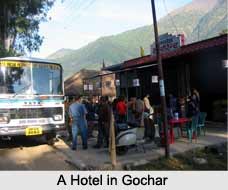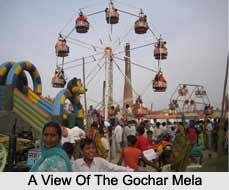 Location of Gochar
Location of Gochar
Gochar is a Hill Town located in Karnaprayag tehsil at Uttarakhand state in India. Gochar is situated on the left bank of the Alakananda river and en route the celebrated holy destination of Badrinath. It is situated at an altitude of 800 metres (2,620 ft) above the sea level. Gochar is surrounded by seven mountains.
Geography of Gochar
This quiet little town is unique in terms of its geographical location and topography. Gochar is located on one of the largest pieces of flatland in this mountainous region of Uttarakhand. Gochar is at 30.28 degrees north and 79.15 degree east.
History of Gochar
Gochar"s area is a large and fat one. It is one of the largest open spaces in the mountainous area of Uttarakhand. This field has served as an airstrip and played host to several dignitaries in the past. It has also been the venue of one of the largest trade fairs in the area. This flat land was the property of the Panwar kings of Garhwal and it was donated by them to the Badrinath Temple at some point in history. It still belongs to the Badrinath Temple and as such is not supposed to be used for agriculture or any other purpose.
Gochar first attained recognition in the 1920s when Lady Willingdon, wife of the then Viceroy of India landed here by air. Then, in 1938, Pandit Jawaharlal Nehru (along with his sister Vijaya Lakshmi Pandit) also came here by air on the way to a personal visit to Badrinath.
Since 1943, Gochar has been a host to one of the largest trade fairs in Uttarakhand. The Bhotias of Chamoli District, residing in the border regions of Garhwal Himalayas, are well known for their traditional expertise in making different kinds of woollen garments and materials, besides processing and colouring of wool. Before 1962, there was trans-border trade between India and former Tibet, and the import of wool was the major source of income for the Bhotia"s woollens-based, indigenous cottage industry. But after 1962, trade was stopped due to conflicts between China and India. The Gochar Mela served as huge market for the Bhotias to sell their ware including woollen products, precious jewels and heeng (asafoetida), and to buy goods for daily necessity such as cloth and salt to carry back with them. This fair was not merely a local fair, but people travelled here from as far as Bijnaur and Kotdwar to participate in the brisk trade.
At a macro level, approximately 1000 AD to 1803, Gochar (in common with the rest of Garhwal) was ruled by the Pal dynasty which later came to be known as the Shah dynasty. In 1803, taking advantage of the devastating earthquake that killed one-third of the region"s population, the Gorkhas advanced towards Garhwal. Pradyuman Shah was the king at that time, and he lost his life and kingdom in the ensuing battle. In common with the rest of Garhwal, Gochar came under Gorkha rule from 1803 to 1815.
Demography of Gochar
As of 2011 India census, Gochar had a population of 7303. Males constitute 58% of the population and females 42%. Gochar has an average literacy rate of 81%, higher than the national average of 59.5%: male literacy is 85%, and female literacy is 76%. In Gochar, 12% of the population is under 6 years of age.
Mela at Gochar
Gochar Mela is a great attraction for the local people and the traders and merchants from all over the state. Organized on the 14th of November every month, Gochar mela is basically an industrial fair. It was organized for the first time in the year 1943.
It is attended by the tourists and local people alike. The cultural programs are also an interesting event here.
After India"s independence, Gochar mela started to be organized by the government as a developmental, industrial and cultural fair.
Transport at Gochar
By road, Gochar is connected with Haridwar and Rishikesh by NH 58 that passes through the town. The nearest railhead is Rishikesh (235 km) and nearest airport is Jolly Grant of Dehradun.
Airport at Gochar
Because of its location on one of the largest pieces of flatland in the mountainous region of Uttarakhand, a 4,000 ft airstrip was constructed at Gochar in 1998-2000 and later upgraded. The airstrip was a vital landing area for rescue and relief efforts following the disastrous North India Floods which ravaged in Uttarakhand in June 2013.



















